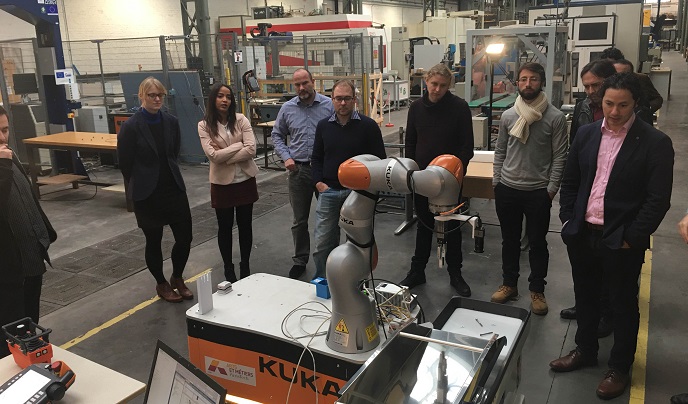Multitasking robots work hand-in-hand with operators
The automotive and aerospace industries share common challenges: huge backlogs of orders and a growing need for flexibility to meet market demands. Most of us have probably faced this problem when ordering a new car – we want to be able to ‘shop’ from a long list of options, and we can’t wait for the dealer to call us and say that our brand-new car has just arrived and is ready for pick-up. It’s no different for the satellite industry. So far, this need for more productivity and flexibility has translated into growing automation of production lines. But such automation takes on a new dimension when robots can actually collaborate with humans in a shared workspace. Enter ColRobot (Collaborative Robotics for Assembly and Kitting in Smart Manufacturing), an H2020 project that has spent the past three years working on an integrated collaborative robotic system. Their technology consists of a mobile manipulator which acts as a ‘third hand’ for production line workers: It can autonomously move around the factory looking for pieces or tools, deliver them or hold them while the operator performs another task. Two versions for two end-users The solution was completed in two versions: one for Renault, and one for Thales Alenia Space. Renault uses the robot to remove non-ergonomic sequences of assembly tasks, while TAS uses it to automate low-level tasks while letting humans focus on tasks requiring specific expertise or attention. “As far as Thales Alenia Space is concerned, ColRobot essentially supports operators in the preparation of washer and screw kits for satellite assembly operations, in the delivery of assembly kits directly to the assembly area, and as a third hand assisting the operator in the installation of satellite equipment,” says Prof. Olivier Gibaru, coordinator of the project. “Renault, on the other hand, will benefit from ColRobot by using it to get inside a van and perform tasks such as tightening or quality checks, thereby reducing or even eliminating operator exposure to poor ergonomic conditions.” Other milestone achievements The fact that ColRobot can get into and move inside a van to perform assembly operations alongside the operator is perhaps one of the project’s most important achievements. But there are others. One of them is a wearable biometric signal capture system developed by Technaid, which recognises movement, orientation and position of the arms, hands and fingers of the operator and sends them to the robot to improve communication capabilities. Fellow consortium member, AKEO+, on the other hand, developed a versatile and flexible three-finger gripper with force sensing which allows the grasping and picking-up of objects of various sizes and shapes. Thanks to an embedded smart sensor, the gripper can also precisely detect, locate and isolate parts. Last but not least, Fraunhofer IFF enriched the system with machine learning techniques to detect the presence of humans in the vicinity of the robot and inform them when they get too close. “The feedback was very positive,” says Prof. Gibaru. “Renault didn’t expect a mobile robot to be able to ride within a van, while TAS operators were very impressed with the overall performance of the system.” TRL7 and beyond ColRobot has now reached TRL7, and Prof. Gibaru says that another two or three years of development will be required for the consortium to propose a usable product. “The solution cost is still very high from a hardware and software perspective, and it is necessary to make adaptations and modifications to the demonstrator before we can consider any industrial deployment.” Meanwhile, both Thales Alenia Space and Renault are already contemplating integration of the ColRobot solutions into new industrial applications.







